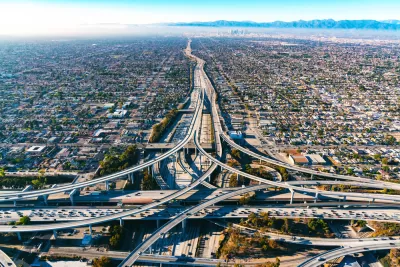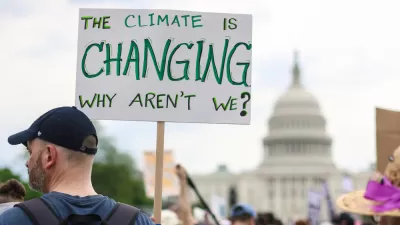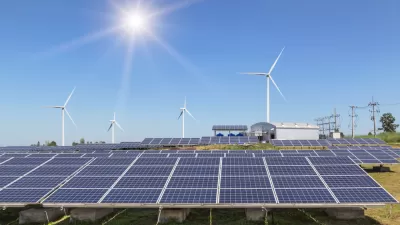2021 greenhouse gas emissions from U.S. transportation increased 10 percent compared to the previous year, pushing the entire world further from the emissions reductions necessary to prevent the worst effects of climate change.

U.S. greenhouse gas emissions increased 6.2 percent compared to 2020 but still remain 5 percent lower than 2019, according to an analysis published today by Rhodium Group based on preliminary data for 2021.
According to the report, U.S. climate emissions are increasing faster that the economy—preliminary economic data estimates that year-on-year GDP grew by 5.7 percent in 2021. The report pins the blame for the rising emission totals on coal-fired power generation, which increased by 17 percent, and a 10 percent of increase from transportation.
Alfredo Rivera, Kate Larsen, Hannah Pitt, and Shweta Movalia summarize the key findings of the report in a note written for the Rhodium Group website:
The transportation and electric power sectors experienced the steepest rise in emissions relative to 2020—10% and 6.6%, respectively—both claiming back about two-thirds of the drop from 2019 levels (Figure 2). Industry, which saw the most modest drop in emissions in 2020 at 6.2%, rebounded 3.6% in 2021—making up just over half the difference from 2019 levels. Buildings saw the smallest rise in GHG emissions in 2021, growing only 1.9% from 2020, returning only a quarter of the drop in emissions from 2020.
The article also breaks down the emissions increases for the transportation sector:
Despite hopes that life would get back to normal in 2021, passenger travel never fully recovered to 2019 levels. After falling 13% in 2020, gasoline demand—indicative of demand for on-road passenger travel—rose steadily through 2021, ending the year 10% above 2020 levels. Despite air travel’s dramatic surge in 2021 (rising 26%), it remained down 24% below 2019 levels. Road freight was the only transport mode that rebounded beyond 2019 levels in 2021. Continued demand for consumer goods kept freight demand high, even surpassing 2019 levels for several months of the year. On a year-on-year basis, aggregate diesel demand rose 9% from 2020 levels, putting it at 0.4% above 2019 levels.
The transportation sector's rebounding carbon emissions once again reveal the deeply ingrained role fossil fuels are in the economy. Even with millions of Americans taking their cars off the roads while working from home, sprawling development patterns, the separation of uses, and the lack of alternative transportation infrastructure ensures that any economic increase will ride on the back of combustions engines.
The Washington Post and the Boston Globe picked up news of the report, both focusing on the news in context of the Biden administration's goals to cut the nation's emissions in half by 2030, but the consequences of the country's backsliding on carbon emissions are far broader than a political agenda. According to the Sixth Assessment Report, published by the U.N.'s International Panel on Climate Change in August 2021, the world has a greenhouse has budget of 500 gigatons of carbon dioxide –about what humans produce every ten years—to keep the warming of the planet below 1.5 degrees Celsius by the end of the century.
The source article provides more detail about the coal sector's resurgence in the past year, resulting from increased prices from natural gas, as well as how the year's results impact the country's commitment to the Paris Climate Agreement.
FULL STORY: Preliminary US Greenhouse Gas Emissions Estimates for 2021

Planetizen Federal Action Tracker
A weekly monitor of how Trump’s orders and actions are impacting planners and planning in America.

Map: Where Senate Republicans Want to Sell Your Public Lands
For public land advocates, the Senate Republicans’ proposal to sell millions of acres of public land in the West is “the biggest fight of their careers.”

Restaurant Patios Were a Pandemic Win — Why Were They so Hard to Keep?
Social distancing requirements and changes in travel patterns prompted cities to pilot new uses for street and sidewalk space. Then it got complicated.

Maui's Vacation Rental Debate Turns Ugly
Verbal attacks, misinformation campaigns and fistfights plague a high-stakes debate to convert thousands of vacation rentals into long-term housing.

San Francisco Suspends Traffic Calming Amidst Record Deaths
Citing “a challenging fiscal landscape,” the city will cease the program on the heels of 42 traffic deaths, including 24 pedestrians.

California Homeless Arrests, Citations Spike After Ruling
An investigation reveals that anti-homeless actions increased up to 500% after Grants Pass v. Johnson — even in cities claiming no policy change.
Urban Design for Planners 1: Software Tools
This six-course series explores essential urban design concepts using open source software and equips planners with the tools they need to participate fully in the urban design process.
Planning for Universal Design
Learn the tools for implementing Universal Design in planning regulations.
Heyer Gruel & Associates PA
JM Goldson LLC
Custer County Colorado
City of Camden Redevelopment Agency
City of Astoria
Transportation Research & Education Center (TREC) at Portland State University
Camden Redevelopment Agency
City of Claremont
Municipality of Princeton (NJ)





























